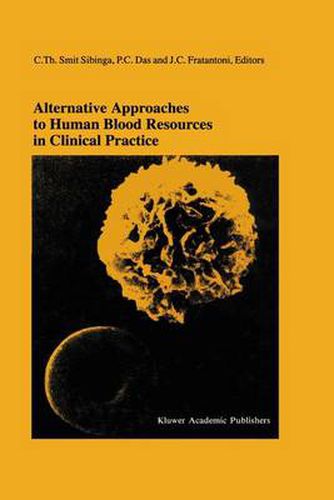Readings Newsletter
Become a Readings Member to make your shopping experience even easier.
Sign in or sign up for free!
You’re not far away from qualifying for FREE standard shipping within Australia
You’ve qualified for FREE standard shipping within Australia
The cart is loading…






This title is printed to order. This book may have been self-published. If so, we cannot guarantee the quality of the content. In the main most books will have gone through the editing process however some may not. We therefore suggest that you be aware of this before ordering this book. If in doubt check either the author or publisher’s details as we are unable to accept any returns unless they are faulty. Please contact us if you have any questions.
Blood is a volatile issue at the end of the 20th century. The safety of blood and the quantification of transfusion risks have been dominant themes that have stimulated the development of alternative approaches in this rapidly developing area. In clinical medicine conventional blood and its components are used in supportive therapies dependent on the choice of apparent uncritical trigger factors. A compounding factor is depth of prospective clinical trials for evidence. Such trials in critical care areas would be of enormous value, not only in recording adverse effects and under-transfusion, but also indicating the value of decision analysis and cost-effectiveness in transfusion practice. Alternative approaches include the use of cytokines, growth factors, humanized monoclonal antibodies, recombinant plasma factors, and buffy coat derived natural human interferons. These are being increasingly implemented in the clinic. Solutions for oxygen transport are being developed and fibrinogen coated microcapsules are being investigated for thrombocytopenia. In surgical patients, various crystalloid and colloid combinations are explored as volume replacements. As we approach the year 2000, the major concerns about transfusion medicine remain its logistics, safety and effectiveness. This text presents the theme, covering the proceedings of the 22nd International Symposium on Blood Transfusion, developed in 21 up-to-date topics, collected and discussed in four sections. This text should be of value to students, professionals and all others interested or involved in the field of transfusion medicine, whether clinical or related.
$9.00 standard shipping within Australia
FREE standard shipping within Australia for orders over $100.00
Express & International shipping calculated at checkout
This title is printed to order. This book may have been self-published. If so, we cannot guarantee the quality of the content. In the main most books will have gone through the editing process however some may not. We therefore suggest that you be aware of this before ordering this book. If in doubt check either the author or publisher’s details as we are unable to accept any returns unless they are faulty. Please contact us if you have any questions.
Blood is a volatile issue at the end of the 20th century. The safety of blood and the quantification of transfusion risks have been dominant themes that have stimulated the development of alternative approaches in this rapidly developing area. In clinical medicine conventional blood and its components are used in supportive therapies dependent on the choice of apparent uncritical trigger factors. A compounding factor is depth of prospective clinical trials for evidence. Such trials in critical care areas would be of enormous value, not only in recording adverse effects and under-transfusion, but also indicating the value of decision analysis and cost-effectiveness in transfusion practice. Alternative approaches include the use of cytokines, growth factors, humanized monoclonal antibodies, recombinant plasma factors, and buffy coat derived natural human interferons. These are being increasingly implemented in the clinic. Solutions for oxygen transport are being developed and fibrinogen coated microcapsules are being investigated for thrombocytopenia. In surgical patients, various crystalloid and colloid combinations are explored as volume replacements. As we approach the year 2000, the major concerns about transfusion medicine remain its logistics, safety and effectiveness. This text presents the theme, covering the proceedings of the 22nd International Symposium on Blood Transfusion, developed in 21 up-to-date topics, collected and discussed in four sections. This text should be of value to students, professionals and all others interested or involved in the field of transfusion medicine, whether clinical or related.